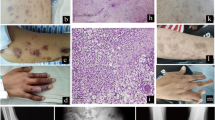Abstract
Three cases are reported of hypogammaglobulinemic males with recurrentCampylobacter jejuni septicemia and erysipelas-like cellulitis without diarrhoea. In one patientCampylobacter jejuni grew from skin biopsy specimens. The findings in another patient were strongly suggestive of osteomyelitis caused byCampylobacter jejuni. Since the susceptibility of hypogammaglobulinemic patients to infection withCampylobacter jejuni is probably related to a lack of serum bactericidal activity againstCampylobacter jejuni due to lack of IgM, two patients in whom previous antimicrobial treatment failed were treated with plasma infusions. This regimen supplemented with imipenem resulted in cure of these relapsing infections.Campylobacter jejuni septicemia must be considered in hypogammaglobulinemic patients who present with periodic fever and cellulitis.
Similar content being viewed by others
References
Blaser MJ, Reller LB Campylobacter enteritis. New England Journal of Medicine 1981, 305: 1444–1452.
Ahnen DJ, Brown WR Campylobacter enteritis in immunodeficient patients. Annals of Internal Medicine 1982, 96: 187–189.
Pönkä A, Tilvis R, Kosunen TU ProlongedCampylobacter gastroenteritis in a patient with hypogammaglobulinaemia. Acta Medica Scandinavica 1983, 213: 159–160.
Lever AML, Dolby JM, Webster ADB, Price AB ChronicCampylobacter colitis and uveitis in a patient with hypogammaglobulinaemia. British Medical Journal 1984, 288: 531.
Melamed I, Bujanover U, Igra YS, Schwartz D, Zakerth V, Spirer Z Campylobacter enteritis in normal and immunodeficient children. American Journal of Diseases of Children 1983, 137: 752–753.
Johnson RJ, Nolan C, Wang SP, Shelton WR, Blaser MJ PersistentCampylobacter jejuni infection in an immunocompromised patient. Annals of Internal Medicine 1984, 100: 832–834.
van der Meer JWM, Mouton RP, Daha MR, Schuurman RKB Campylobacter jejuni bacteraemia as a cause of recurrent fever in a patient with hypogammaglobulinaemia. Journal of Infection 1986, 12: 235–239.
Chusid MJ, Coleman CM, Dunne MW Chronic asymptomaticCampylobacter bacteraemia in a boy with X-linked hypogammaglobulinaemia. Pediatric Infectious Disease Journal 1987, 6: 943–944.
Spelman DW, Davidson N, Buckmaster ND, Spicer WI, Ryan P Campylobacter bacteraemia: a report of 10 cases. Medical Journal of Australia 1986, 145: 503–505.
LeBar WD, Menard RR, Check FE Hypogammaglobulinemia and recurrentCampylobacter jejuni infection. Journal of Infectious Disease 1985, 152: 1099–1100.
Skirrow MB Campylobacter enteritis. A “new” disease. British Medical Journal 1977, ii: 9–11.
Lior H New, extended biotyping scheme forCampylobacter jejuni, Campylobacter coli andCampylobacter laridis. Journal of Clinical Microbiology 1984, 20: 636–640.
Lior H, Patel A Improved toluidine blue-DNA agar for detection of DNA hydrolysis byCampylobacters. Journal of Clinical Microbiology 1987, 25: 2030–2031.
Lauwers S, Vlaes L, Butzler JP Campylobacter serotyping and epidemiology. Lancet 1981, i: 158–159.
Sahm DF, Washington JA Antibacterial susceptibility tests: dilution methods. In: Balow A, Hausler WJ, Hermann KL, Isenberg HD, Shadomy HJ (ed): Manual of clinical microbiology. American Society for Microbiology, Washington, DC, 1991, p. 1105–1116.
Roord JJ, van der Meer JWM, Kuis W, van Furth R Treatment of antibody deficiency with subcutaneous infusion of gammaglobulin. In: Wedgwood RJ, Rosen FS, Paul NW (ed): Primary immunodeficiency diseases. Birth defects. Alan R. Liss, New York, 1983, p. 217–221.
Rubin RH, Fischman AJ, Callahan RJ, Khaw BA, Keech F, Ahmad M, Wilkinson R, Strauss HW 111 Inlabeled nonspecific immunoglobulin scanning in the detection of focal infection. New England Journal of Medicine 1989, 321: 935–940.
Oyen WJG, Claessens RAMJ, van Horn JR, van der Meer JWM, Corstens FHM Scintigraphic detection of bone and joint infections with indium-111 labeled nonspecific polyclonal human immunoglobulin G. Journal of Nuclear Medicine 1990, 31: 403–412.
Oyen WJG, van Horn JR, Claessens AMJ, Sloof TJJH, van der Meer JWM, Corstens FHM Diagnosis of bone, joint and joint prosthesis infections with indium-111 labeled nonspecific human immunoglobulin G. Radiology 1992, 182: 195–199.
Lederman HM, Winkelstein JA X-linked agammaglobulinaemia: an analysis of 96 patients. Medicine 1985, 64: 145–156.
Wyatt RA, Younoszai K, Anuras S, Myers MG Campylobacter fetus septicemia and hepatitis in a child with agammaglobulinemia. Journal of Pediatrics 1977, 91: 441–442.
Pedler SJ, Bint AJ Osteitis of the foot due toCampylobacter jejuni. Journal of Infection 1984, 8: 84–85.
Blaser MJ, Smith PF, Kohler PF Susceptibility ofCampylobacter isolates to the bactericidal activity of human serum. Journal of Infectious Diseases 1985, 151: 227–235.
Endtz HP, van der Meer JWM, Mouton RP Campylobacter jejuni bacteraemia in hypogammaglobulinaemia: emergence of ciprofloxacin resistance and results of serum bactericidal assays. In: Kaijser B, Falsen E (ed): Proceedings of the Fourth International Workshop onCampylobacter Infections. University of Göteburg, Küngalve, Sweden, 1988, p. 150–151.
Perlman DM, Ampel NM, Schifman RB, Cohn DL, Patton CM, Aguirre ML, Wang WL, Blaser MJ PersistentCampylobacter jejuni infections in patients infected with human immunodeficiency virus (HIV). Annals of Internal Medicine 1988, 108: 540–546.
Endtz HP, Mouton RP, van der Reyden T, Ruijs GJ, Biever M, van Klingeren B Fluoroquinolone resistance inCampylobacter spp. isolated from human stools and poultry products. Lancet 1990, 335: 787.
Author information
Authors and Affiliations
Rights and permissions
About this article
Cite this article
Kerstens, P.J.S.M., Endtz, H.P., Meis, J.F.G.M. et al. Erysipelas-like skin lesions associated withCampylobacter jejuni septicemia in patients with hypogammaglobulinemia. Eur. J. Clin. Microbiol. Infect. Dis. 11, 842–847 (1992). https://doi.org/10.1007/BF01960888
Issue Date:
DOI: https://doi.org/10.1007/BF01960888



